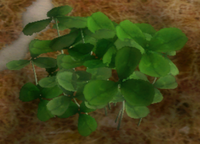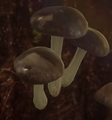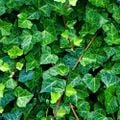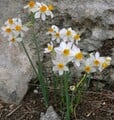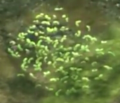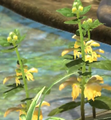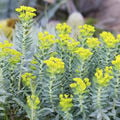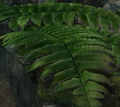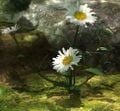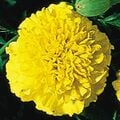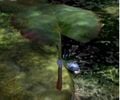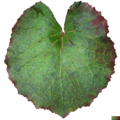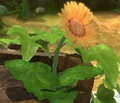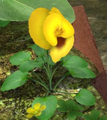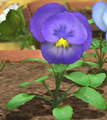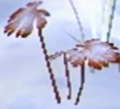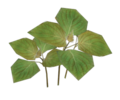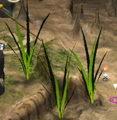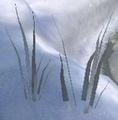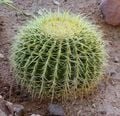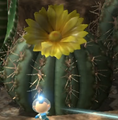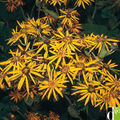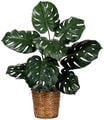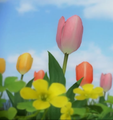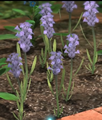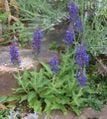Vegetation
- "Leaf" redirects here. For the characters in Pikmin 4, see Leafling.
- This article is about vegetation in the canon games. For vegetation in Pikmin Adventure, see Pikmin Adventure vegetation.
Areas in the Pikmin series are covered in all sorts of vegetation in addition to their animal wildlife. This includes an assortment of plants and fungi. Most vegetation exists as background scenery to add visual interest and to create a sense of the biome the area is in, but some vegetation has gameplay functions too. Some particular plants and fungi are given names in Pikmin 2's Piklopedia, though because the explorers are not specialists in plant and fungus lifeforms familiar to humans, they mistakenly categorize things like LED lights as fungi. In addition, Captain Olimar refers to Pikmin as being "both plant and animal".[1]
Vegetation as game objects[edit]
Some forms of vegetation are game objects, much like the leaders or the Pikmin. They are dotted about the terrain, and most of them have minimal impact on the gameplay, serving only for decoration; at most, they gently sway when brushed against. However, while some plants and fungi may be decorative in and of themselves, upon touching them they may release some helpful enemies hiding within, like Unmarked Spectralids, Honeywisps or Iridescent Flint Beetles. Others can also act as hiding spots from predators. Finally, there is a small handful of plant and fungus objects that have an important role as a gameplay mechanic, such as being an obstacle.
Piklopedia[edit]
- Main article: Piklopedia (Pikmin 2).
The Piklopedia is an in-game feature in Pikmin 2. When the leaders interact with enemies and vegetation, a record about the entity is created on the Piklopedia. In order for the player to complete the Piklopedia, they must touch at least one specimen of every recognizable plant and fungus in the game. Pikmin 3 Deluxe's Piklopedia does not contain entries for plants.
Gameplay mechanics[edit]
|
To do: list all interactive Hey! Pikmin vegetation. |
Some forms of vegetation in PNF-404 are actually helpful or obstructive to the leaders and their Pikmin, and serve as important gameplay mechanics – some must be interacted with to complete the game.
 Pellet Posies have a single pellet on top of their stem. When the plant is taken down, it releases the pellet inside, which can be brought to an Onion. This provides a safe way of increase Pikmin population without having to interact with enemies or their corpses.
Pellet Posies have a single pellet on top of their stem. When the plant is taken down, it releases the pellet inside, which can be brought to an Onion. This provides a safe way of increase Pikmin population without having to interact with enemies or their corpses.
 Burgeoning Spiderworts contain berries that, when delivered to the ship can be used to brew sprays. These plants can generate several berries throughout the day, making them a good origin of sprays; they do, however, need some upkeep in order to remain a healthy and reliable source.
Burgeoning Spiderworts contain berries that, when delivered to the ship can be used to brew sprays. These plants can generate several berries throughout the day, making them a good origin of sprays; they do, however, need some upkeep in order to remain a healthy and reliable source.
 Burgeoning Spiderwort molds in Pikmin 2 suffocate Burgeoning Spiderworts and any Pellet Posies within their radii, rendering the plants inaccessible until the central molds are destroyed.
Burgeoning Spiderwort molds in Pikmin 2 suffocate Burgeoning Spiderworts and any Pellet Posies within their radii, rendering the plants inaccessible until the central molds are destroyed.
 Candypop Buds are plants that can take in Pikmin and convert them to a different type.
Candypop Buds are plants that can take in Pikmin and convert them to a different type.
 Nectar weed is a type of grass that, when pulled out, has a chance of releasing a drop of nectar. Pikmin can be told to weed out these blades of grass in order to obtain the nectar within.
Nectar weed is a type of grass that, when pulled out, has a chance of releasing a drop of nectar. Pikmin can be told to weed out these blades of grass in order to obtain the nectar within.
 Common Glowcaps in Pikmin 3 light up the area around them. This provides both lighting and protection from Phosbats and the Vehemoth Phosbat.
Common Glowcaps in Pikmin 3 light up the area around them. This provides both lighting and protection from Phosbats and the Vehemoth Phosbat.
 Spotcaps are often simply destructible scenery, but sometimes they can block a pathway or even contain Data Files.
Spotcaps are often simply destructible scenery, but sometimes they can block a pathway or even contain Data Files.
 Kingcaps always appear in dense collections of Spotcaps, blocking a path until Pikmin destroy it.
Kingcaps always appear in dense collections of Spotcaps, blocking a path until Pikmin destroy it.
 Bloominous Stemples open up when lit, and serve as bridges to cross gaps.
Bloominous Stemples open up when lit, and serve as bridges to cross gaps.
 Bouncy Mushrooms launch any Pikmin or leaders to a specific spot nearby.
Bouncy Mushrooms launch any Pikmin or leaders to a specific spot nearby.
 Flukeweeds hold items in their roots; Winged Pikmin can pull them out to retrieve the items.
Flukeweeds hold items in their roots; Winged Pikmin can pull them out to retrieve the items.
 Lily pads float on the surface of rivers, and allow leaders and Pikmin to ride them to new sections of the area.
Lily pads float on the surface of rivers, and allow leaders and Pikmin to ride them to new sections of the area.
 Springpetals are large flowers in caves that, when weighed with Pikmin, fling them upward. The more weight added to a flower, the higher its contents will be propelled.
Springpetals are large flowers in caves that, when weighed with Pikmin, fling them upward. The more weight added to a flower, the higher its contents will be propelled.
 Electric glowcaps are minor obstacles that do damage to leaders that touch them and emanate light. Because of their electric properties, Yellow Pikmin are immune to the their effects and can temporarily disable them.
Electric glowcaps are minor obstacles that do damage to leaders that touch them and emanate light. Because of their electric properties, Yellow Pikmin are immune to the their effects and can temporarily disable them.
 Leaf platforms are minor obstacles that blow straight forward when the air is windy, but slump down when it is clear, which happens frequently throughout the area they're in. They act as platforms that the player can walk across.
Leaf platforms are minor obstacles that blow straight forward when the air is windy, but slump down when it is clear, which happens frequently throughout the area they're in. They act as platforms that the player can walk across.
Treasures as vegetation[edit]
In Pikmin 2 and Pikmin 4, the leaders attribute a high value to some otherwise mundane plants and fungi. These forms of vegetation have been upgraded from mere decorative objects to important treasures that the player must collect in order to complete the game. The following is a list of series whose treasures do not act as regular in-game vegetation:
Pikmin 2[edit]
Pikmin 4[edit]
 Spring Crop Series
Spring Crop Series Summer Fruit Series
Summer Fruit Series Autumn Harvest Series
Autumn Harvest Series Winter Reserve Series (except the Merciless Extractor)
Winter Reserve Series (except the Merciless Extractor) Tropical Pickings Series
Tropical Pickings Series Nature's Candy Series
Nature's Candy Series
Enemies as vegetation[edit]
Some enemies in the Pikmin world take advantage of the unassuming characteristics of flora and fungi in order to disguise themselves as common vegetation. This can be either a defensive or offensive mechanism, in that the disguise could serve as a way to hide from predators, or as a means for an ambush. In addition, some enemies also seem to be part plant or part fungus, much like how the Pikmin are part plant themselves. A list of enemies with these plant and fungus connections is as follows:
 Bulbmin: as they are but a parasitic form of Pikmin, they too are half-plant in nature.
Bulbmin: as they are but a parasitic form of Pikmin, they too are half-plant in nature. Creeping Chrysanthemum: they belong to the same family of plants as the Margaret, and disguise themselves as one in order to ambush prey. It is even stated by Olimar that they are actually plants, being the only enemies in the series with this trait.[2]
Creeping Chrysanthemum: they belong to the same family of plants as the Margaret, and disguise themselves as one in order to ambush prey. It is even stated by Olimar that they are actually plants, being the only enemies in the series with this trait.[2] Startle Spore: similar to the Creeping Chrysanthemum, these enemies also disguise to ambush prey. However, instead of using flowers as camouflage, they use mushrooms instead.
Startle Spore: similar to the Creeping Chrysanthemum, these enemies also disguise to ambush prey. However, instead of using flowers as camouflage, they use mushrooms instead. Skitter Leaf: these enemies disguise themselves as mere leaves in order to prevent predation.
Skitter Leaf: these enemies disguise themselves as mere leaves in order to prevent predation. Desiccated Skitter Leaf: same as Skitter Leaves, except these attack Pikmin.
Desiccated Skitter Leaf: same as Skitter Leaves, except these attack Pikmin. Puffstool: these mushroom-like enemies release spores that can take over Pikmin.
Puffstool: these mushroom-like enemies release spores that can take over Pikmin. Toxstool: these enemies are very similar in design to the Puffstool, but can poison Pikmin instead of infect them.
Toxstool: these enemies are very similar in design to the Puffstool, but can poison Pikmin instead of infect them. Puffstalk: these enemies are also very mushroom-like, and hide in holes in the background.
Puffstalk: these enemies are also very mushroom-like, and hide in holes in the background. Berserk Leech Hydroe: this boss is said to have been a simple plant once, but was turned into a monster because of a parasite.
Berserk Leech Hydroe: this boss is said to have been a simple plant once, but was turned into a monster because of a parasite.
Misc.[edit]
Interestingly, in New Play Control! Pikmin and New Play Control! Pikmin 2, Yellow Pikmin thrown from a plant will reach a higher distance. This does not apply to the GameCube versions.
Vegetation as terrain[edit]
The terrain in PNF-404 consists of all sorts of surfaces. Given the series' highlights of nature, a large part of the terrain Pikmin and leaders walk on is made up of flora or fungi. This can range from grass to tree trunks. These different terrains count simply for decoration, as they have no impact on the gameplay, other than providing different footstep sounds when leaders walk on top of them.
Vegetation as background[edit]
In order to give the areas some physical context, the out of bounds sections of the terrain are filled with plants and fungi. At times, it is even in much larger amounts than what can be found in the area's in-bound terrain; the reason for this is to stop the gameplay section of the area to be too cluttered. The outside of maps can consist of normal vegetation gameplay objects, dedicated models (e.g. trees, leaves, or unique flowers), or, in the case of the first two games, a wall with a texture of assorted vegetation, like mossy stones or trees.
List of identified vegetation[edit]
The following is a list of identified plants and fungi in the Pikmin games. This list refers to vegetation that is given an actual name or recognition inside the games, but also vegetation that has a mechanic in the game, and not just aesthetics. Only Pikmin 2 actually names most of these, with the Piklopedia. You may also browse the categories available on Pikipedia, with the top one being Vegetation.
Pikmin[edit]
 Clover
Clover Candypop Bud
Candypop Bud Common Glowcap
Common Glowcap Dandelion
Dandelion Figwort
Figwort Nectar weed (conjectural name)
Nectar weed (conjectural name) Onion
Onion Pellet Posy
Pellet Posy Shoot
Shoot
- See also: Pikmin vegetation category.
Pikmin 2[edit]
 Burgeoning Spiderwort
Burgeoning Spiderwort Clover
Clover Common Glowcap
Common Glowcap Crimson Candypop Bud
Crimson Candypop Bud Dandelion
Dandelion Fiddlehead
Fiddlehead Figwort
Figwort Foxtail
Foxtail Glowstem
Glowstem Golden Candypop Bud
Golden Candypop Bud Horsetail
Horsetail Ivory Candypop Bud
Ivory Candypop Bud Lapis Lazuli Candypop Bud
Lapis Lazuli Candypop Bud Margaret
Margaret Mold
Mold Nectar weed (conjectural name)
Nectar weed (conjectural name) Onion
Onion Pellet Posy
Pellet Posy Queen Candypop Bud
Queen Candypop Bud Seeding Dandelion
Seeding Dandelion Shoot
Shoot Violet Candypop Bud
Violet Candypop Bud
- See also: Pikmin 2 vegetation category.
Pikmin 3[edit]
- See also: Pikmin 3 vegetation category.
Pikmin 4[edit]
- See also: Pikmin 4 vegetation category.
Hey! Pikmin[edit]
|
The following article or section is in need of assistance from someone who plays Hey! Pikmin. |
 Bloominous Stemple
Bloominous Stemple Bouncy Mushroom
Bouncy Mushroom Clover
Clover Electric glowcap (conjectural name)
Electric glowcap (conjectural name) Hydroe bramble (conjectural name)
Hydroe bramble (conjectural name) Leaf platform (conjectural name)
Leaf platform (conjectural name) Onion
Onion Seeding Dandelion
Seeding Dandelion Sparklium flower
Sparklium flower Sparklium Seed
Sparklium Seed- [icon] Spiked pine cone
 Springpetal
Springpetal Vine (conjectural name)
Vine (conjectural name)
- See also: Hey! Pikmin vegetation category.
Pikmin Adventure[edit]
Plants and fungi in Pikmin Adventure are once again decorative and hardly interactive, but there are Nintendo Land Plaza statues for each of them. These are unlocked using Nintendo Land Coins.
List of unidentified vegetation[edit]
There are forms of vegetation that are not given a name or any sort of importance inside the games themselves. However, their species can still be known by examining how they look and act, compared to plants and fungi in the real world. Some vegetation, however, cannot be identified at all, either because they do not resemble any real world plant, or because the resemblances are too weak to reach conclusive proof. The names given on this list are the real world names.
Barrenwort[edit]
Patches of Barrenwort[3] (Epimedium grandiflorum) appear in Pikmin 3, acting as hiding spots in the Distant Tundra.
Brown mushrooms[edit]
Brown mushrooms appear in Pikmin 3, and they grow on trees. It is not possible to interact with them. These mushrooms should not be confused with Dusty Mushrooms, another type of brown mushroom that grows on the ground.
Blaxcap and Bulborel[edit]
Blaxcaps and Bulborels (デメマダラタケ?, lit.: "Spotted Bug-eye Mushroom") are mushrooms said to grow rarely on the backs of Emperor Bulblaxes and Sovereign Bulblax respectively. The name "Bulborel" seems to be a portmanteau of "Bulborb" and "morel".
Common ivy[edit]
Hedera helix, or common ivy, is a rampant and clinging plant often found on walls. It is possible to see this kind of plant in Pikmin 3.
A brown common ivy in the Twilight River.
Common poppy[edit]
There is a red flower in Pikmin 3 which resembles Papaver rhoeas, also known as the common poppy, a common ornamental plant.
Daffodil[edit]
Daffodil[3] plants appear in Pikmin 3, in the Distant Tundra and Twilight River. Due to the cool climates of both areas, they don't have visible flowers, so it's easy to confuse them for generic reeds. Their name was revealed in Japanese supplementary material, confirming their species as daffodil.
Duckweed[edit]
Plants belonging to the subfamily Lemnoideae, commonly known as duckweed, can be seen growing over the ponds and lakes of the Garden of Hope in Pikmin 3.
Dwarf Arrowhead[edit]
Dwarf Arrowhead[3] appears in the Garden of Hope in Pikmin 3. It can also be found growing on the Quaggled Mireclops.
Eaten leaves[edit]
In the background of Tropical Wilds in Pikmin 3, it's possible to see leaves that seem to have been eaten by something.
Euphorbia[edit]
Euphorbiae are flowering plants that can be seen in Pikmin 3.
Fern[edit]
Ferns are large plants that reproduce through spores, they appear in Pikmin, Pikmin 2, and Pikmin 3, and more precisely, in two colors: brown or green.
A group of green ferns in the Tropical Wilds.
A group of brown ferns in the Twilight River.
A group of brown ferns in the Wistful Wild.
A fern in The Impact Site.
Fleabane[edit]
Fleabane[3] (Erigeron) appears in Pikmin 3 and Pikmin 4. It is seen growing in the Garden of Hope acting as decoration, though a White Spectralids will normally land on a group near the landing site in the Garden of Hope. In Pikmin 4, Creeping Chrysanthemums resemble Fleabane while hiding.
Forget-me-not[edit]
Forget-me-nots are small flowering plants belonging to the genus Myosotis; they appear in Pikmin 3 in the Beastly Caverns stage of Mission Mode and the Shaded Terrace stage of Bingo Battle. They are popular garden flowers, only acting as decoration to the garden themes of these two areas.
French marigolds[edit]
Tagetes patula, also called French marigolds, appear in the Garden of Hope in Pikmin 3, in the room with the Astringent Clump.
Fuzzy leaves[edit]
In The Impact Site in Pikmin, it's possible to see strange leaves. Due to the lack of details, it can't be matched with a real plant.
Galax[edit]
Several large flat leaves appear in the background of the Perplexing Pool, serving no other purpose than decoration. These types of leaves are known as peltate leaves; the leaves' stems connect at the bottom, characteristic mainly to tropical plants. The source image for the leaf identifies the exact plant as Galax urceolata.
Peltate leaves of Galax seen in the Perplexing Pool.
The original photograph from Sozaijiten.
Real-life Galax urceolata.
Garland chrysanthemum[edit]
Glebionis coronaria, formerly known as Chrysanthemum coronarium and commonly known as the garland chrysanthemum, is a yellow flowering plant found in Pikmin 3. Although they're similar to Dandelions, they are smaller and have fewer petals.
Glebionis coronaria in the Forgotten Cove.
Gerbera[edit]
In Pikmin 3, it's possible to find flowers very similar to gerberas, however they may share a closer resemblance to Transvaal Daisies.
Golden pothos[edit]
Epipremnum aureum, also known as the golden pothos is a tropical plant characterized by the golden streaks on its leaves. This temperate plant appears in Pikmin 3.
Holly[edit]
Plants belonging to the genus Ilex, commonly known as holly can be seen in the Distant Tundra in Pikmin 3 .
Kelp[edit]
In the north-western beach of the Forgotten Cove in Pikmin 3, various washed up pieces of kelp are seen. Specifically large, pale yellow pieces and smaller, brown pieces.
Morning-glory[edit]
Plants belonging to the family Convolvulaceae, commonly known as morning-glory, are flowering plants that appear in Pikmin 3 in the Forgotten Cove.
A pink morning-glory in the Forgotten Cove.
Pansy[edit]
Pansies[3] are flowering plants bred through hybridization by humans of multiple plants in the genus Viola. These plants appear in Pikmin 3. Depending on the current day, the color of their flowers can change.
A blue pansy as it appears in the Garden of Hope in Pikmin 3.
A yellow pansy in the Garden of Hope. Notice this pansy is located at the same place as the blue pansy.
Pine needle[edit]
Although it is not confirmed, there are needles in Pikmin 3 which seem to be pine needles.
A group of needles in the Distant Tundra in Pikmin 3.
Pink knotweed[edit]
Persicaria capitata, commonly known as the pink knotweed, is a low-growing flowering plant with pink club-like flowers and a white arrow pattern on its leaves. In Pikmin 3, it can be found in The Rustyard.
Red-leafed plant[edit]
It is a red-leafed plant that appears in the first two Pikmin games. It is quite common in Pikmin, appearing in every area. In Pikmin 2, this same plant only appears in the Valley of Repose near the landing area, covered in snow. In Pikmin 2, they belong to the area's geometry, but in Pikmin, it is its own object, called chidome, which could be short for チドメグサ属?. That is the name given to the Hydrocotyle genus (also known as "water pennyworts"), which are plants with long stems that live near water.
A group of red-leafed plants in The Forest Navel.
Riccia fluitans[edit]
In Pikmin, there's a dichotomous strap-shaped aquatic plant that can be found in The Distant Spring, and more precisely in the water. It looks like a hemirosette thallus of Riccia fluitans. It is also possible that it's an aquatic plant called "ambulia" or "asian marshweed".
Rosy Parachute[edit]
Rosy Parachutes[3] (Marasmius pulcherripes) are red mushrooms found in the Tropical Wilds and the Formidable Oak in Pikmin 3. When disturbed by a leader or a Pikmin, they make a unique low-pitched echoing noise. Their Japanese name is ハナオチバタケ?.
Shaggy bracket[edit]
Inonotus hispidus, also known as the shaggy bracket, is a mushroom growing on trees. It appears in Pikmin 3 in autumnal areas such as Twilight River or Twilight Hollow.
Sleeping Beauty[edit]
Sleeping Beauty only appears in Pikmin 3. It only acts as decoration, though one patch near the landing site in the Garden of Hope hides an Iridescent Flint Beetle. It can also be found growing on the Quaggled Mireclops.
An Iridescent Flint Beetle running out of some Sleeping Beauty.
Slender Wild Basil[edit]
Slender Wild Basil[3] (Clinopodium gracile) is made of several little leaves. Its Japanese name is トウバナ?. It appears in the following areas:
- Layout A of the Blooming Terrace
- Twilight River
- Twilight River Remix
- Formidable Oak Remix
- Tropical Forest Remix
- The Rustyard.
Speedwell[edit]
Patches of Speedwell[3] (Veronica polita) appear in Pikmin 3, acting as hiding spots.
Speedwell in the Tropical Wilds.
Spiked grass[edit]
Spiked grass appears in grouped tufts in Pikmin, as decoration for The Forest Navel's landing site. They also appear in Pikmin 2.
Some spiked grass in the Valley of Repose.
Succulent[edit]
|
To do: Describe the other flora in the Formidable Oak in new sections. |
The Formidable Oak in Pikmin 3 features numerous different variants of cacti and succulent plants. These include Haworthia attenuata, stout barrel cacti, Aeonium succulents, and large columnar cacti in the distance. The Formidable Oak also houses some more ambiguous but unique flora, including inflorescences of pink wildflowers, sprouts and tufts of dry grasses, and even some tiny lichens in the center of the arena area. Most of these succulents and some of the flower types are also used in the Thirsty Desert and its remix in Mission Mode.
Summer ragwort[edit]
Ligularia clivorum, commonly known as the summer ragwort, is a flowering plant that appears in the background of The Final Trial in Pikmin and the Garden of Hope in Pikmin 3.
Swiss cheese plant[edit]
Monstera deliciosa, commonly known as the Swiss cheese plant, is a tropical plant used for interior decoration. It appears in Pikmin 3 in the following areas: Tropical Wilds, Tropical Forest and Tropical Forest Remix.
Tree[edit]
|
This article or section is in need of more images. |
Nearly every area of every game (excluding The Forest Navel) contains trees, though most of the time they go unnoticed. Their main effect on gameplay is providing dynamic shadows that make the look of the environment more realistic and interesting. Trees can be seen in most of the backgrounds of the first two games' areas, but the textures depicting them are simple and looped, and often obscured by distance fog. In Pikmin 3, the entire skybox is rendered, and one can see full trees surrounding the area using the KopPad's camera.
The seamless texture for trees in the Valley of Repose.
The background of the Wistful Wild.
Tall oaks in the background of the Garden of Hope.
More tropical trees in the background of the Tropical Wilds.
Trees in the background of the Twilight River.
Acacia-like trees in the background of the Formidable Oak.
Trees in the background of the Distant Tundra.
Tulip[edit]
These only appear in Pikmin 3, and with different colors from normal (such as pink or yellow).
A screenshot from the credits of Pikmin 3 showing different tulips.
Vine[edit]
An ivy-like vine appears in the Tropical Forest in Pikmin 3, creeping along the edge of a raised platform and wall until twirling into a curled slide. Leaders and Pikmin can slide down this vine to get from the raised platform to the lower ground quickly, but not vice versa. Several vines are also used for scenery.
Weed[edit]
A prototype of Pikmin 3 contained an unused patch of weed-like plants.
White mushroom[edit]
In Pikmin 3, it's possible to find a white mushroom in autumnal areas.
The white mushroom in the Twilight Hollow.
Woodland sage[edit]
Salvia nemerosa, commonly known as the woodland sage, is a flowering plant sporting large numbers of small purple flowers. They can be seen in Pikmin 3.
See also[edit]
References[edit]
- ^ “What exactly are these Pikmin? One could classify them as both plant and animal.” – Captain Olimar in his voyage log
- ^ “Like Pikmin, the creeping chrysanthemum is a member of a group of creatures with ambulatory root structures. This creature is known as a "mimic," but because it is actually a form of plant, this label is not entirely accurate. For unknown reasons, the creeping chrysanthemum's mimicry does not fool Pikmin, perhaps because they share a similar heritage. It relies on preying upon other creatures to provide sustenance, so it has no need of leaves for photosynthesis. Generally speaking, the role of plants within an ecosystem is as a producer species, and thus plants are generally found at the bottom of the food pyramid. However, on this strange planet the line between producer plants and consumer plants is blurred.” – Captain Olimar in Olimar's notes on the Creeping Chrysanthemum
- ^ Jump up to: a b c d e f g h Pikmin_3 on The Cutting Room Floor
